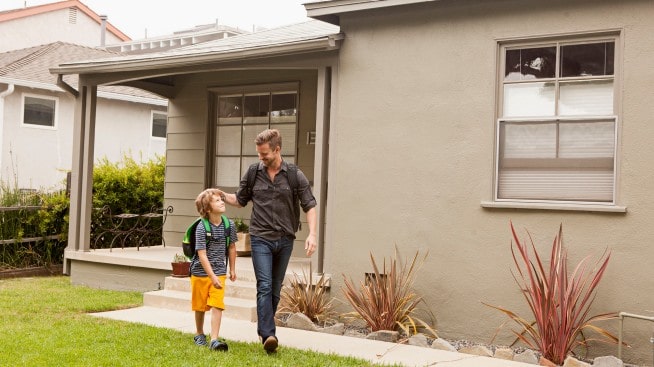Average cost of living by state

Quick insights
- Home prices and rental rates can vary greatly, but those aren’t the only factors that determine cost of living in each state.
- In addition to taxes and healthcare costs, grocery prices, dining out and gas prices fluctuate by state, impacting overall living expenses.
States with a high cost of living often have expensive housing, higher taxes and increased everyday expenses. The cost of living can feel like a maze, with fluctuating prices for housing, food, transportation and healthcare across the United States. Gaining insight into these differences is essential if you’re planning a big move, setting a budget or deciding where to settle.
Whether you’re drawn to the bustling streets of New York or the quiet charm of a small town in the Midwest, knowing the average cost of living by state can help you make more confident choices about your lifestyle. Let's break down how costs vary and what factors you may want to consider when evaluating your options.
How to approach the cost of living by state
The cost of living across the U.S. varies, with some states being significantly more expensive than others. These differences are influenced by several factors, such as demand for housing, state taxes and access to resources. A cost-of-living comparison by state can provide valuable insights for individuals considering relocation for work or retirement.
When comparing living expenses, it’s important to factor in income levels, job availability and quality of life, as a lower cost of living may not always equate to better financial security.
Cost of living: Lowest and highest states
To give you an idea of how cost of living varies widely by state, let’s compare the cost-of-living differences in several states within the United States. Remember, the cost of goods is always evolving; therefore, research specific information on states you might move to.
States with low cost of living
According to U.S. News & World Report, the states with the lowest cost of living are Mississippi, Arkansas, Iowa, Alabama and South Dakota.ec-usnews-cost-living
Mississippi
The average Mississippi home value is $179,182, up 3.8% over the past year and goes to pending in around 43 days.ec-usnews-cost-living The cost of living in Mississippi is 13% lower than the national average. Housing is 29% lower than the national average, while utilities are 11% lower.ec-usnews-cost-living
Arkansas
The average Arkansas home value is $207,284, up 3.9% over the past year and goes to pending in around 50 days.ec-usnews-cost-living The cost of living in Arkansas is 8% lower than the national average. Housing is 23% lower than the national average, while utilities are 6% lower.ec-rentcafe-ark-apr25
Iowa
The average Iowa home value is $216,891, up 5.1% over the past year and goes to pending in around 41 days.ec-usnews-cost-living The cost of living in Iowa is 6% lower than the national average. Housing is 19% lower than the national average, while utilities are 5% lower.ec-rentcafe-iowa-apr25
Alabama
The average Alabama home value is $225,539, up 2.6% over the past year and goes to pending in around 40 days.ec-usnews-cost-living Cost of living in Alabama is 12% lower than the national average. Housing is 38% lower than the national average, while utilities are 11% higher.ec-rentcafe-alab-apr25
South Dakota
The average South Dakota home value is $302,465, up 3.9% over the past year and goes to pending in around 38 days.ec-usnews-cost-living The cost of living in South Dakota is 7% lower than the national average. Housing is 12% lower than the national average, while utilities are 14% lower.ec-usnews-cost-living
States with high cost of living
According to U.S. News & World Report, the states with the highest cost of living are Hawaii, California, New York, Massachusetts and Oregon.ec-usnews-cost-living
California
The average California home value is $784,840, up 3.0% over the past year and goes to pending in around 25 days.ec-usnews-cost-living The cost of living in California is 38% higher than the national average. Housing is 97% higher than the national average, while utilities are 24% higher.ec-usnews-cost-living
New York
Cost of living in New York can vary widely depending on the city. The cost of living in New York is 26% higher than the national average. Housing is 75% higher than the national average, while utilities are 3% higher.ec-usnews-cost-living
Massachusetts
The average Massachusetts home value is $628,654, up 5.1% over the past year and goes to pending in around 15 days.ec-usnews-cost-living The cost of living in Massachusetts is 46% higher than the national average. Housing is 108% higher than the national average, while utilities are 16% higher.ec-rentcafe-mass-apr25
Oregon
The average Oregon home value is $494,836, up 1.9% over the past year and goes to pending in around 35 days.ec-usnews-cost-living The cost of living in Oregon is 10% higher than the national average. Housing is 22% higher than the national average, while utilities are 3% lower.ec-rentcafe-ore-apr25
Key components of the cost of living
Several factors contribute to the overall cost of living, affecting affordability from state to state. Here are some of the main components:
- Housing: This is typically the biggest expense. Home prices and rental rates vary widely, making some states far more expensive than others.
- Food: Grocery and dining costs differ based on factors like transportation expenses and local supply, with some states facing higher prices due to limited access to goods.
- Transportation costs: Gas prices, public transit fares and commuting costs can impact daily expenses. Some states may have significantly higher fuel prices or fewer public transit options.
- Healthcare costs: Costs for medical care, insurance premiums and prescription medications vary across states, influencing overall affordability.
- Taxes: State and local taxes (including income, sales, and property taxes) can vary, with some states having no income tax and others having high tax rates.
Generally, high-cost states like New York and California may offer strong job markets and higher median incomes. However, the housing, transportation and everyday expenses than increase the overall cost of living there. In contrast, states with a lower cost of living like North Carolina or Tennessee might provide more affordable housing and lower taxes. This could potentially allow residents to stretch their income.
The national average cost of living
The national average cost of living provides a useful benchmark for comparing expenses across different states. It helps individuals gauge whether a particular state is more or less expensive than the average. It is usually based on factors like housing, food transportation, healthcare costs and taxes.
States with a cost-of-living index above the national average tend to have higher expenses, while those below it are generally more affordable. For example, if a state has a cost-of-living index of 120, it is 20% more expensive than the national average. Conversely, if a state has a cost-of-living index of 80, it is 20% less expensive than the national average.
While the cost-of-living index offers a broad comparison, actual living expenses can vary depending on lifestyle choices and specific locations within a state. This benchmark does not account for individual circumstances such as income levels or personal spending habits, which can greatly influence how affordable a place feels.
How to plan for the cost of living in your state
Planning for the cost of living in your state can help you manage expenses and make informed financial decisions. Follow these tips to create a solid plan:
- Research the average cost of living: Look at the typical costs for housing, food, transportation, healthcare and other necessities in your state. Understanding these expenses will give you a clearer picture of what to expect.
- Compare costs to your income: Assess your earnings against essential living expenses. This can determine whether you can comfortably afford your current lifestyle or if adjustments are needed.
- Consider additional factors: Beyond the cost of living, think about job opportunities, quality of life and proximity to family and friends. A lower cost of living may not always outweigh other important lifestyle considerations.
- Use a cost-of-living calculator: If you’re thinking about moving to a different state, consider using a cost-of-living calculator to estimate how much you would need to earn to maintain your current standard of living.
- Create a budget: Based on your research, develop a budget that accounts for both fixed and variable expenses. This can help you plan for savings and unexpected costs.
- Re-evaluate regularly: The cost of living can change over time due to inflation and other economic factors. Periodically review your expenses and adjust your budget as needed to stay prepared when making long-term moving plans.
In summary
When making decisions about where to live, your budgeting and financial planning is linked to the cost of living by state. Housing, food and transportation costs can differ. While the national average provides a helpful comparison, true affordability depends on your personal circumstances and priorities.
The right state for you will offer a balance between cost and other factors, such as job opportunities, quality of life and personal preferences. With careful planning, you can make choices that support your goals.



